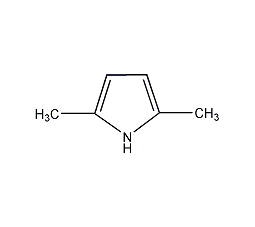2,5-Dimethylpyrrole


Structural formula
| Business number | 06SH |
|---|---|
| Molecular formula | C6H9N |
| Molecular weight | 95.14 |
| label |
2,5-dimethyl-1H-pyrrole, 2,5-Dimethyl-1H-pyrrole |
Numbering system
CAS number:625-84-3
MDL number:MFCD00005223
EINECS number:210-913-8
RTECS number:UX9465930
BRN number:None
PubChem number:24893274
Physical property data
1. Character: yellow to orange or brown liquid.
2. Density (g/mL,25/4℃): 0.935
3.Relative vapor density (g/mL,Air=1): Undetermined
4. Melting point (ºC): Undetermined
5. Boiling point (ºC,Normal pressure): 165
6. Boiling point (ºC,5.2kPa): Undetermined
7. Refractive index: 1.505
8 . Flash Point (ºC): 54
9. Specific optical rotation (º): Undetermined
10. Autoignition point or ignition temperature (ºC): Undetermined
11. Vapor pressure (kPa,25ºC): Undetermined
12. Saturated vapor pressure (kPa,60ºC): Unconfirmed.��
13. Heat of combustion (KJ/mol): Undetermined
14. Critical temperature (ºC): Undetermined
15. Critical pressure (KPa): Undetermined
16. Oil and water (octanol/Log value of water) partition coefficient: Undetermined
17. Explosion upper limit (%,V/V): Undetermined
18. Lower explosion limit (%,V/V): Undetermined
19. Solubility: Extremely difficult to dissolve in water.
Toxicological data
1, acute toxicity:Rat (oral)LD50: 59mg/kg
Since the LD50 of table salt is 3,000 mg/kg, the acute toxicity of BPA is the same as that of table salt.
Ecological data
Do not discharge into drains.
Molecular structure data
1. Moore refraction Rate: 30.33
2. Molar Volume (cm3/mol):100.3
3. isotonic ratio (90.2K):242.1
4. Surface Tension (dyne/cm):33.9
5. Polarization Rate(10-24cm3):12.02
Compute chemical data
1. Reference value for hydrophobic parameter calculation (XlogP): None
2. Number of hydrogen bond donors: 1
3. Number of hydrogen bond acceptors: 0
4. Number of rotatable chemical bonds: 0
5. Number of tautomers: none
6. Topological molecule polar surface area 15.8
7. Number of heavy atoms: 7
8. Surface charge: 0
9. Complexity: 53.2
10. Number of isotope atoms: 0
11. Determine the number of atomic stereocenters: 0
12. Uncertain number of atomic stereocenters: 0
13. Determine the number of chemical bond stereocenters: 0
14. Number of uncertain chemical bond stereocenters: 0
15. Number of covalent bond units: 1
Properties and stability
Keep away from strong oxidants, strong acids, and sources of fire.
Storage method
Store in an airtight container in a cool, dry place. Keep away from oxidants and sources of fire. Keep refrigerated.
Synthesis method
Will2,5-Heat hexanedione and ammonium carbonate together until the foaming stops, about1-1.5h, then115℃ slowly reflux for half an hour, cool, and separate the upper layer, that is2,5-Dimethylpyrrole. The lower layer of the above reactant is extracted with chloroform, and part of the product can also be recovered. The crude product is distilled under reduced pressure and collected 51-53℃(1.07kPa) or78-80℃(3.33kPa) fraction to obtain the finished product. Yield81-86% .
Purpose
Organic synthesis intermediates.